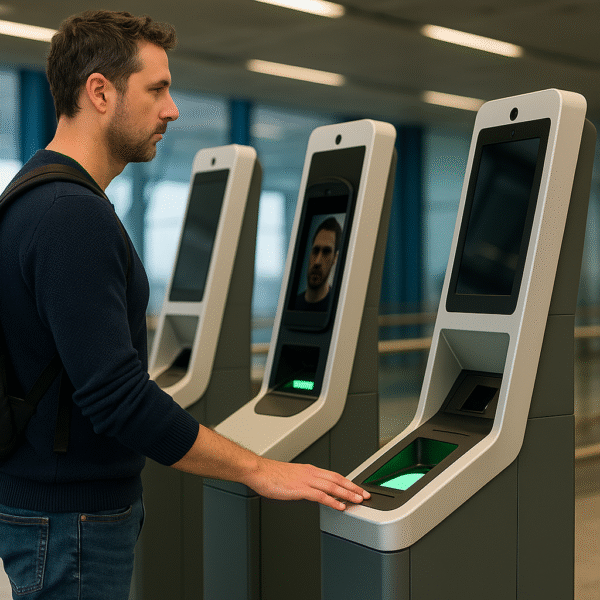From October 12, 2025, the European Union will launch the Entry Exit System (EES), a major shift in how non-EU nationals, including UK citizens, enter and exit the Schengen Area. The system introduces biometric checks to replace traditional passport stamping, marking a historic change in Europe’s border security approach. For millions of travelers, particularly those from the United Kingdom, this will mean new processes at ports, airports, and train stations.
The EES is designed to create digital records of entry and exit, ensuring more secure and efficient monitoring of traveler movements. It also aims to reduce errors and prevent passport fraud while making crossings smoother in the long term.
What is the Entry Exit System (EES)?
The Entry Exit System is an EU-wide initiative that uses biometric data—fingerprints and facial recognition—to record the arrival and departure of non-EU nationals. Each traveler’s biometric details will be stored for three years, allowing faster passage on future visits without the need to resubmit information.
The system will fully replace the traditional stamping of passports. This change brings uniformity across Schengen borders and enhances the EU’s ability to combat illegal immigration. While initial crossings may take longer as travelers adapt, the system is expected to create a faster, more reliable process in the long term.
The rollout will take place in phases, with full implementation targeted for April 10, 2026. During this transition, travelers will experience a mix of old and new methods at border points.
Impact on UK Travelers
Since the UK is no longer part of the EU, British travelers will be among those directly affected by the EES. Major points of departure where UK travelers will face the new system include:
- St Pancras International: Eurostar passengers will register biometrics before boarding. Fingerprint scanning and facial recognition will become part of the streamlined check-in process.
- Port of Dover: From October 12, Eurotunnel travelers will begin using biometric kiosks. Ferry passengers will follow from November 1, entering their details through self-service terminals.
- Eurotunnel Folkestone Terminal: Coaches, freight vehicles, and commercial traffic will begin checks in October, with personal vehicle passengers joining in November.
Children under 12 will not need to provide fingerprints but will still undergo registration for future compliance. Authorities stress the importance of early preparation, particularly for families and frequent travelers.
Eurostar’s Preparations at St Pancras
Eurostar is investing heavily to ensure a smooth transition. At St Pancras International, 49 self-service kiosks have been installed across three dedicated areas, part of an £11 million project to prepare for the October rollout.
The design emphasizes efficiency, aiming to prevent bottlenecks even during peak holiday travel. Eurostar is working closely with UK and EU border agencies to test the new system and minimize waiting times. With passenger volumes often spiking during school breaks and festive seasons, the upgraded facilities are expected to play a crucial role in maintaining punctuality and traveler satisfaction.
Phased Rollout and What Travelers Should Expect
The EES will not be introduced everywhere at once. Instead, it will be phased in gradually, with different entry points transitioning at different times. This staged rollout will allow border authorities to monitor performance, fix technical issues, and adapt to traveler feedback.
Travelers should anticipate slightly longer processing times at first, particularly during busy weekends and holidays. Authorities recommend arriving earlier than usual to accommodate the biometric registration process. Once travelers’ details are logged, repeat journeys should be faster and more efficient.
Looking Ahead: ETIAS in 2026
In addition to the EES, the European Union is preparing to introduce the European Travel Information and Authorisation System (ETIAS) by the end of 2026. This system will apply to nationals of visa-exempt countries, including the UK.
Under ETIAS, UK citizens will need to apply for online travel authorization before entering the Schengen Area. The process will involve a short application and security check, with approvals typically valid for three years or until the traveler’s passport expires.
ETIAS will not replace the EES but will work alongside it. Together, the two systems will provide a comprehensive digital record of travel movements, bolstering security while streamlining checks at entry points.
Preparing for the Future of EU Travel
The introduction of the Entry Exit System marks a turning point for European travel. For UK citizens, it means adjusting to biometric registration, longer initial wait times, and greater digital oversight. However, these changes are designed to reduce fraud, strengthen security, and create smoother journeys in the years ahead.
Eurostar’s investment and preparations at St Pancras International highlight the importance of readiness, while ports such as Dover and Folkestone are upgrading facilities to handle the shift.
As ETIAS comes into effect in 2026, UK travelers will need to adapt once again to an additional layer of border requirements. With proper planning and awareness, these measures should make future trips more efficient and secure.
For now, the advice is clear: allow extra time, be ready for biometric checks, and stay informed about new travel requirements. The EU’s digital border revolution is just around the corner—and it will reshape the travel experience for millions of visitors.
For more travel news like this, keep reading Global Travel Wire














